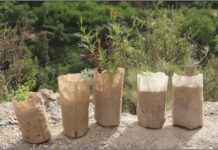Farmers consider how other species influence crops to create a nourishing agricultural environment. Hungry insects, fungi and animals search for delicious dinners and put farms at risk, so crops need effective yet healthy ways to deter pests.
Environmental concerns grow as the density of pesticides detected in soil, air, water and organisms rises. Chemical-free alternatives like kaolin clay could be a solution for protecting plants using local resources.
Kaolin clay is a plentiful and accessible resource for African agriculturalists. There are over 290 kaolin clay deposits on the continent. Smartly harvesting this natural resource could create a safety net for the future of plants and farmers.
What Is Kaolin Clay?
Kaolin is a soft, white clay important to many industries like ceramics, cosmetics and papermaking. Farmers can use it in powder form as a pesticide to spray on crops to act as a protective coating. Fortunately, it is also insoluble in water, so it likely won’t harm aquatic populations.
The clay shield repels pests from eating through every part of the plant, including leaves and roots. The qualities of kaolin clay are comparable to diatomaceous earth. Its dusty texture works best on dry foliage to dehydrate creatures like aphids. Due to the coating, other animals and insects may not even see the plant as edible. As a result, you may see pests around crops, but they are still safe.
Luckily, the human health risk is low to nonexistent compared to other pesticides. Due to its extensive testing in other industries, including consumables like toothpaste, research must thoroughly assert human safety.
How to Use It to Replace Traditional Pesticides
When working with kaolin clay in powder form, it is advisable to wear protective equipment on the eyes, nose and mouth to avoid dust particle irritation. Though it is harmless to humans, it may make the experience more comfortable.
Making the mixture is simple — put 3 cups of kaolin clay powder per 1 gallon of water. Progressively stir water onto the dry mix so the clay doesn’t stick or create lumps.
Kaolin clay is FDA approved to work for a wide array of fruits and vegetables. Farmers should appropriately spray crops every seven to 14 days, ensuring the sun is not too harsh and avoiding product overuse.
Since it works best on dry plants, spraying in the rain or using sprinklers is not recommended — get the most of the resources available by watering crops close to the soil for best results. Cover the plants entirely with the spray, as vulnerable spots are sure to welcome determined pests.
After application, a thin white film should be visible. This can aid in showing how thoroughly the spray coated the plants.
Does It Work as Well?
The key to desirable results is correct kaolin clay administration. Kaolin clay is an excellent insect repellent and provides an effective sunscreen for crops.
Kaolin has reflective properties, so sun damage and temperature control aren’t stressors. These properties have allowed an increase in South African apple yields.
Seeing results is a long-term reward as farmers harvest more at the end of each season. This benefit is because populations of notable pests are lessened when faced with kaolin clay. Researchers analyzed cotton farms that used it as a pesticide and found it significantly reduced the number of aphids eating crops.
What’s the Best Option in Agriculture?
Creative solutions to harmful pesticides are posited constantly in the world of agriculture. Environmentally friendly farmers want to focus on healthy crops while posing the least harm to native populations possible.
The benefits of considering kaolin clay as a pesticide include:
- Having greater protection from the sun
- Easy mixture and application
- Decreased use of chemicals affecting the ecosystem
- Utilizing materials native to the area
With the EPA’s approval and OMRI listing it as a pesticide for solar protection, the word is out on how positively influential kaolin clay can be to harvest output. Determining the unequivocal best solution is potentially close, but kaolin clay provides a chemical-free alternative for now.
 Jane is an agriculture and environmental journalist and the founder and editor-in-chief of Environment.co, where she covers sustainability and eco-friendly living.
Jane is an agriculture and environmental journalist and the founder and editor-in-chief of Environment.co, where she covers sustainability and eco-friendly living.









